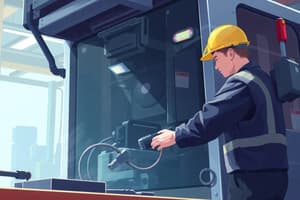Podcast
Questions and Answers
The ______ of electricians is crucial in controlling electrical accidents.
The ______ of electricians is crucial in controlling electrical accidents.
role
Good illumination is essential for enhancing ______ in workplaces.
Good illumination is essential for enhancing ______ in workplaces.
safety
The ______ Act provides relevant provisions for electrical safety regulations.
The ______ Act provides relevant provisions for electrical safety regulations.
Indian Electricity
Ventilation is important for maintaining a comfortable ______ environment.
Ventilation is important for maintaining a comfortable ______ environment.
The concept of ______ is vital for maintaining cleanliness and safety in the workplace.
The concept of ______ is vital for maintaining cleanliness and safety in the workplace.
The statutory provision related to principles in machine guarding is essential for ensuring the safety of ______.
The statutory provision related to principles in machine guarding is essential for ensuring the safety of ______.
When handling materials, avoiding excessive muscular ______ is crucial for safety.
When handling materials, avoiding excessive muscular ______ is crucial for safety.
Lifting machinery such as cranes and elevators must be designed with specific ______ to ensure safe operation.
Lifting machinery such as cranes and elevators must be designed with specific ______ to ensure safe operation.
Hand tools should be inspected and maintained regularly to control ______ accidents.
Hand tools should be inspected and maintained regularly to control ______ accidents.
Understanding the safety limits of ______ is important to prevent electrical hazards.
Understanding the safety limits of ______ is important to prevent electrical hazards.
Buried electrical for protection from ______ hazards requires proper installation and maintenance.
Buried electrical for protection from ______ hazards requires proper installation and maintenance.
Using the correct ______ when lifting different shapes and sizes of objects is essential for worker safety.
Using the correct ______ when lifting different shapes and sizes of objects is essential for worker safety.
Portable power tools require careful selection and ______ for safe usage in various tasks.
Portable power tools require careful selection and ______ for safe usage in various tasks.
Flashcards
Static Electricity Hazards
Static Electricity Hazards
The dangers of static electricity buildup, such as sparks that can ignite flammable materials or cause electrical shocks.
Electrician's Role in Safety
Electrician's Role in Safety
Electricians are crucial in preventing electrical accidents by properly installing, maintaining, and inspecting electrical systems to ensure they are safe and compliant with regulations.
Lighting and Safety
Lighting and Safety
Good lighting in workplaces is vital for safety as it improves visibility, reduces eye strain, and allows workers to identify hazards easily.
Pressure Vessel Safety
Pressure Vessel Safety
Signup and view all the flashcards
Housekeeping for Safety
Housekeeping for Safety
Signup and view all the flashcards
Machine Guarding
Machine Guarding
Signup and view all the flashcards
Types of Guards
Types of Guards
Signup and view all the flashcards
Safe Lifting Techniques
Safe Lifting Techniques
Signup and view all the flashcards
Mechanical Handling
Mechanical Handling
Signup and view all the flashcards
Safe Use of Lifting Machinery
Safe Use of Lifting Machinery
Signup and view all the flashcards
Hand Tools and Safety
Hand Tools and Safety
Signup and view all the flashcards
Electrical Hazards
Electrical Hazards
Signup and view all the flashcards
Electrical Safety Precautions
Electrical Safety Precautions
Signup and view all the flashcards
Study Notes
Machine Guarding
- Statutory provisions: Outline principles for machine guarding.
- Types of guards: Detail various guard designs and selection criteria.
- Specific machinery: Detail guarding for woodworking, paper, rubber, printing, and machine tools, emphasizing special precautions.
- Built-in safety devices: Discuss incorporated safety mechanisms.
- Maintenance and repair: Highlight maintenance and repair procedures for guards.
- Incidental safety devices and tools: Discuss supplementary safety equipment.
- Workplace design: Cover plant and work area layout for safety.
Manual Handling and Storage
- Hazards in manual handling: Identify risks in manual material handling.
- Avoiding excessive effort: Discuss strategies to prevent overexertion.
- Safe lifting methods: Describe effective techniques for material handling.
- Maximum load limits: Specify permissible weights for lifting.
- Object characteristics: Discuss safe lifting techniques for different shapes, sizes, and weights.
- Accessories for handling: Describe safe use of handling accessories.
- Material storage: Emphasize proper material storage methods.
Mechanical Handling of Materials
- Lifting machinery: Cover cranes, elevators, conveyors, dumpers, and pay loaders.
- Design, construction, and testing: Discuss safety considerations during these phases.
- Operator training: Underscore safe operation, signaling, inspection, and maintenance procedures for machine operators.
- Power trucks and tractors: Detail safety features, operation, maintenance, and inspection.
- Lifting tackles: Discuss various lifting equipment (chain slings, rope slings, fibre and wire rings, hooks, shackles, swivels, eye bolts).
- Safe working load: Explain calculation procedures for safe load capacities.
Hand Tools and Portable Power Tools
- Tool accident causes: Identify common causes of accidents related to tools.
- Accident control: Describe preventive measures for tool accidents.
- Centralized tool control: Discuss central tool management systems.
- Tool purchase, storage, and supply: Highlight procedures for acquiring, storing, and distributing tools.
- Inspection, maintenance, and repair: Emphasize inspection, maintenance, and repair schedules for tools.
- Tool failure causes: Detail reasons for tool failures.
- Tool tempering, sharpening, and dressing: Describe these essential procedure for safe tool use.
- Tool handles: Highlight the importance of proper handles.
- Tool types: Detail types of hand tools for various tasks (metal cutting, woodworking, miscellaneous cutting, material handling, torsion tools, shock tools, non-sparking tools).
- Portable power tools: Explain tool selection, inspection, maintenance, and repair for safe usage.
Electrical Hazards
- Electricity dangers: Discuss the hazards associated with electricity.
- Safety limits: Discuss safety limits for amperage and voltage.
- Safe distances from lines: Highlight safe distances from electrical lines.
- Conductor capacity & protection: Explain conductor safeguards and protection methods.
- Joints and connections: Detail safe electrical connections and jointing procedures
- Power cutoff methods: Detail methods for isolating electrical power.
- Overload and short circuit protection: Stress the importance of appropriate protection.
- Earth fault protection: Highlight safeguards against earth faults.
- Tests: Emphasize earth, insulation, and continuity testing procedures.
- Overvoltage protection: Explain protection against overvoltage hazards.
- Portable electrical apparatus: Detail precautions for portable electrical devices.
- Flameproof equipment: Discuss flameproof electrical equipment.
- Electrical equipment: Describe safe selection, installation, maintenance, and use of electrical equipment.
- Static electricity control: Outline methods for controlling static electricity hazards.
- Electrician's role: Detail the electrician's responsibilities for reducing electrical accidents.
Industrial Lighting
- Lighting purpose and benefits: Summarize the role of good lighting.
- Lighting and safety: Explain the correlation between lighting and safety.
- Lighting and work: Relate illumination levels to work efficiency.
- Lighting types and sources: Detail the different types of lighting.
- Illumination principles: Outline principles of effective illumination.
- Illumination standards: Detail minimum illumination standards (values).
- Lighting design, maintenance, and color: Explain design, maintenance, and color application principles.
Safety of Pressure Vessels
- Statutory provisions: Detail regulations covering pressure vessel safety.
- Fired and unfired vessels: Discuss safety provisions for both types.
- Testing requirements: Outline essential testing requirements for pressure vessels.
- Testing methods: Discuss various testing methods.
- Design and construction: Detail safety aspects during design and construction.
- Boilers: Cover safety precautions and operation guidelines.
Ventilation and Heat Control
- Ventilation purpose: Explain the importance of ventilation.
- Thermal environment: Discuss measurement of thermal conditions.
- Heat regulation: Relate human physiology to heat regulation.
- Thermal comfort: Explain the concepts of thermal comfort.
- Heat stress indices: Describe indices for assessing heat stress.
- Thermal limits: Explain thermal limits for comfortable working conditions.
- Ventilation types: Detail natural, mechanical, air conditioning, and process ventilation methods.
- Heat exposure control: Describe control measures, focusing on source control, insulation, local exhaust ventilation, and radiant heat control.
Housekeeping
- 5S concept: Describe the 5S method and its importance for safety.
- Management responsibility: Stress management commitment to a safe environment.
- Safety engineer's role: Highlight the role of safety engineers in housekeeping.
- Planning and follow-up: Emphasize the importance of proper planning & follow-up.
- Cooperation: Stress the need for employee cooperation.
- Unsafe housekeeping examples: Describe common unsafe housekeeping practices.
- Scrap and waste disposal: Detail procedures for scrap and waste disposal.
- Spillage prevention: Explain ways to prevent material spills and leaks.
- Marking: Detail the marking of walkways.
- Color coding: Describe the use of color for effective housekeeping.
- Clean-up campaigns: Discuss the implementation and value of periodic clean-up events.
Special Precautions
- Working at height: Cover procedures & safeguards.
- Confined spaces: Include precautions for working in confined spaces.
- Work permits: Describe the necessity of permits for high-risk tasks (e.g., working at height or confined spaces).
Laws and Regulations
- Factories Act & Rules: Include relevant provisions from the Factories Act.
- Indian Electricity Act & Rules: Include relevant provisions.
- Explosive Act & Rules: State pertinent provisions.
- Gas Cylinders Rules: Detail pertinent provisions.
Studying That Suits You
Use AI to generate personalized quizzes and flashcards to suit your learning preferences.




